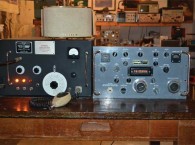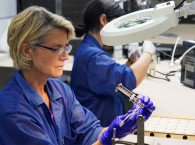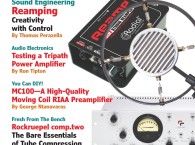The simple one-story building, home to the Vintage Radio and Communications Museum of Connecticut, provides few clues to the immense, historical collection contained within its brick and mortar walls. The virtual time capsule is filled floor to ceiling with more than a century of technological developments.
But hidden from public view is where the real treasure is for audiophile DIYers. Tucked in the back corner of the warehouse are floor-to-ceiling shelves containing a mind-boggling assortment of vacuum tubes. If you need to repair a vintage radio, television, ham radio, guitar amplifier or hi-fi device, the Vintage Radio and Communications Museum may be just the place for you. The museum has thousands of new and used vacuum tubes available for sale. The tubes are all donated to the museum, and there are more than one museum can possibly display so the overflow is sold to audiophiles all over the world.

The Museum
The museum itself — 4,000-square feet of display space — began with its founder, John Ellsworth, and his healthy obsession with history. Ellsworth taught public school for 35 years, beginning with tech education classes in 1975. “That’s when I started going to flea markets and tag sales. One time I saw a small radio, and said to myself, ‘Let’s see if I can fix that,’ and that turned into all this,” Ellsworth explained. “One day, I realized I had 200 antique radios, phonographs, and other bits laying around the house and thought I had the makings of a museum.”
That was in 1990. Twenty-three years and six locations later, the museum has more than 30 active volunteers who have taken “ownership” of various museum exhibits. “This museum is all volunteer-run, and privately funded,” said Ellsworth. “Our volunteers often start out as visitors. They come back, migrate to what they enjoy, and pretty soon, they are taking care of the portion of the museum.”
“It hasn’t been easy and we have continually had to come up with new and creative ways to fund the museum. But, here in this building that we (and the bank) now own, we have a sense of permanence. And, I really feel the collection—this museum—has really taken on a life of its own.”
In addition to the 4,000-square-feet of displays, there is another 7,000-square-feet of storage space. Every bit of it is filled (in many places from floor to ceiling). “Sometimes the amount of stuff that has been donated to us is a little overwhelming, but we are so grateful to all the people who have contributed,” Ellsworth said.
Potential Audio DIYer Goldmine
Donated items that are nice but not historically significant are categorized and sold on eBay to help keep the museum’s coffers in the black. The back “storage space” also contains a mini warehouse with an estimated 40,000 to 50,000 new and used vacuum tubes. The tubes, vintage radio equipment, and schematics from the Rider’s and Sam’s series are available for sale. “We are paying the mortgage and keeping the lights on. Things are going okay for us,” Ellsworth said. “We also offer a few classes in radio repair and crystal radio construction.”
The tubes are tested on either a Hickok mutual conductance tester or a Heathkit emissions tester and the volunteers only ship tubes that test a least 70% to ensure that they work properly. The used tubes sell at a 40% discount from the new old stock (NOS) tubes so they’re reasonably priced. All the tubes sold are guaranteed to be in good condition on delivery, with no shorts or leaks.
Electronic Advances
The museum celebrates the history of electronic communications, tracing its development from the mid 1880s to the 1980s advent of home computers. Visitors can send a message in Morse code listen to 100-year-old records on an old phonograph, and learn about the telegraph, telephone, and more.
An entire area is devoted to radios from the 1920s and 1930s and the museum owns some of the first television sets from the 1950s. Among the vintage hi-fi-equipment sits a large glass case filled with vacuum tubes. Across the room, there is a HAM radio room, with a working W1VCM station. Adjacent to the HAM radio station is the DeGeorge Memorial recording studio. The studio, with its amazing array of vintage microphones, can record music and vocals and all formats of audio equipment, enabling transcriptions of vintage sound recordings to modern digital format.
Museum volunteer Dan Thomas, a retired broadcast engineer from Colorado has been instrumental in getting the studio in working order. He is now working on the television display.
“I discovered the museum a little over a year ago. I saw some information about it on the Internet, dropped in one day, and fell in love with it. This is heaven to me,” Thomas said, adding that he spends 15 to 20 hours per week at the museum. “It is fantastic that there is so much history, not only about radio and broadcasting, but also about Connecticut and the surrounding area.”
Chris Kelling, of Manchester, is a HAM radio operator who has volunteered at the museum since 2010. “We have a very active group of volunteers and I’ve met many people who share my interests in communications. We’ve amassed considerable history here, and I hope the museum continues to attract new people.”
Ellsworth often gives narrated tours of the museum. Along the way, groups can view a rare monotype machine, a spring-driven Victrola, and a second-generation Amberol with Edison cylinders stored in its original cabinet. “Back then, the bigger the horn, the bigger the sound,” said Ellsworth.
Within the motion picture section sits a plain wooden box, which Ellsworth said could possibly be the rarest piece in the museum.
“After a great deal of research, we discovered that the box belonged to a traveling production group. They never knew if there was going to be electricity from one theater to the next, so they used this equipment to light the stage. That’s where the term ‘limelight’ actually comes from,” explained Ellsworth. The patent date is the 1870—the stage coach era.”
Ellsworth also discussed Guglielmo Marconi and the invention of telegraphy. But even more intriguing was the story of Reginald Aubrey Fessenden and his broadcast of “Silent Night” on Christmas Eve 1906. “It was the very first radio broadcast,” Ellsworth explained, as he walked passed a huge display aisle filled with radios.
“It original took three different dials to find a station. You had to write down the settings and record them in a log book so you could find it again. You really had to know what you were doing to make it work.”
Back then, the radio was very prestigious, and the pieces were remarkable because many of them were made during the late 1920s. Radios really became central to the home, and the furniture era began in 1927, Ellsworth explained.
Vacuum Tube Potential
Technology, now moving at light speed, shows no end in sight. But, Ellsworth said he is proud of the feelings the museum evokes in his visitors. “It’s amazing. In the beginning, when I started this, if I didn’t do anything, nothing happened. Now, if I do nothing, it will run me over. The museum really has a life of its own. We’ve got something really good here, and we are going to keep it going.”
For audiophiles in need of tubes, the museum has several types available including 6L6, 6V6, 12AX7, 12AU7, 12AT7, 6SN7, 5U4, 5Y3, 6F6, KT66, and 6BQ5 tubes. Although the museum does not yet have an online tubes catalog, there is a form available on its website. Once you fill out a firm, volunteers can contact you regarding availability and pricing.
Ellsworth said the most popular and the most valuable are the high-end audio output tubes. Our customers come from all over the world, but we sell quite a few to people in Russia, Japan, Australia, and Thailand,” Ellsworth said.
The Vintage Radio and Communications Museum is located at 115 Pierson Lane, Windsor, CT 06095. Call (860) 683-2903 or visit their website for more information. The museum is open year round: Thursday and Friday, 10 AM to 3 PM., Saturday, 10 AM to 5 PM, and Sunday, 1 PM. to 4 PM.






